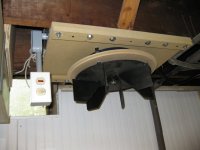110V off 220V continued ...
110V off 220V continued ...
I'm assuming that your setup, like mine, is in a residential setting. Your house should be supplied with 220V Single phase. All the 110V circuits in your house are derived off a pairing of one leg of the 220V and the neutral (white wire) - ( Red to Black = 220V, Red to White = 110V, Black to White = 110V).
In my setup (previous post) one leg (red-white) powers the relay, and the other (black-white) powers the box fan.
Need to watch your breaker capacity. A 220V breaker will act like two joined 110V breakers. The cyclone motor draw plus the draw off either individual 110V leg will be added and if exceeded will trip your breaker. Kept happening to me during motor starting. If the cyclone motor started and got to speed, it would keep going; but sometimes (randomly) startup motor surge + 110V loads kept tripping my breaker. This was solved by increasing breaker capacity. As I already had a larger 220V breaker, this was far cheaper than running a dedicated 110V circuit.
Additionally, drawing 110V off the 220V cyclone supply is safer as one dedicated breaker serves the device. If a dedicated 110V supply is run, one MUST make sure that both the 220V and 110V sources are off during electrical servicing.



